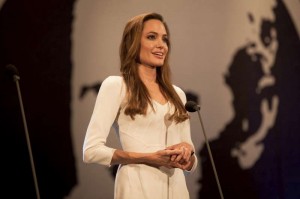WHEN Angelina Jolie bravely went public with her decision to undergo a double mastectomy because of her high risk of breast cancer, health authorities everywhere prepared for a wave of renewed interest and concern in the deadly disease.
The world-famous actor discovered she was carrying the faulty BRCA1 gene, which carries with it a consequential high risk of breast cancer. Both Jolie’s mother and aunt died from the disease so she made the calculated decision to have the surgery to decrease her chances of acquiring the cancer.
For her part, Jolie went to great measures to get the point across, writing an op-ed piece in the New York Times, calling to make the procedure, along with genetic screening, more affordable for the average American woman.

Angelina Jolie’s public discussion of breast cancer has sparked the ‘Jolie effect’.
Source: AcnurLasAmericas
Here in Victoria the reaction to Jolie’s surgery proved to be not so much a wave as a tsunami. In the days following the star’s announcement, almost 4,000 breast screen appointments were made in Victoria alone.
BreastScreen Victoria CEO Vicki Pridmore said the organisation felt the direct impact of the celebrity’s announcement.
“As demonstrated by Kylie Minogue, Gina Riley and Kerri-Anne Kennerley, when well-known and much loved women are diagnosed with breast cancer, the news has a dramatic impact on women who may put off having a regular mammogram,” said Pridmore.
“In the three days following Angelina’s announcement, BreastScreen Victoria received 5,148 calls to the call centre which resulted in 4,888 bookings. This is an additional 2,142 calls more than usual, and an extra 1,901 bookings.”
For Australians who meet criteria similar to Jolie, breast screening and genetic testing is partially government-funded, making it more affordable and thus accessible to the general public.
The “Jolie effect”, as it has become known, was credited by the Cancer Council Victoria with creating an increase in breast cancer enquiries to their help line by a whopping 1033%.
Krystal Barker, founder of charity Pink Hope, shares a personal tie with Jolie. Like the star, she underwent a preventative double mastectomy following changes detected in a routine mammogram at the young age of 25.
“I do understand why Angelina chose that option, because I did it for the very same reason. I watched every woman in my family live with the scars and fears associated with hereditary cancer. It became a grey cloud that hovered over me … I never dreamed of a future with my family because I truly never believed I had one.Today I am about to turn 30, have three beautiful children, a husband who loves me and the fear of breast cancer doesn’t keep me up at night.”
Mother-of-two Sue Magnabosco decided to have a mammogram last week after learning of Jolie’s surgery on the news.
“I turned 50 last year and reading about Angelina’s calls for preventive action against breast cancer really resonated with me. I thought about the bigger picture – my family – and why I want to be there for the long haul,” said Sue.
Jan Knight has had regular breast screening for the past decade.
“We have family history. I’ve lost my sister, aunt, grandmother and great-mother to breast cancer, so being proactive with breast screening and taking precautions is really important to me. Angelina Jolie’s article in the New York Times has also inspired my family to look into genetic testing,” said Jan.
In addition to the rise in screenings, the rate of local referrals for breast cancer genetic testing have more than doubled since Jolie went public.
While the awareness Jolie has raised can only be a good thing, there has also been a downside to the sudden flooding of inquiries from worried Victorians. In particular, doctors working at familial cancer programs across the state are reporting high instances of women seeking genetic testing, despite the majority of them failing to meet criteria to warrant a test.
Resources are being stretched by the huge increase in demand being experienced post-Jolie. Authorities fear that women who actually have a high possibility of having one or both of the faulty genes may now be stuck in queues behind people with extremely low risk indicators. As it is, statistics indicate only 5% of breast cancers are caused by BRCA1 and BRCA2 faulty genes.
“My only concern is it is putting a strain on an already struggling area,” said Krystal. “It is the one area where support, information and resources are so crucial. Pink Hope and the Family Cancer Clinics definitely need financial support from the government to keep up with the influx.”
Although some of the local response could be considered panic reaction, health authorities are confident more education will lead to better health management among women. Australia has one of the highest rates of breast cancer per capita in the world and members of the medical community stress breast cancer must remain a priority of the government.

